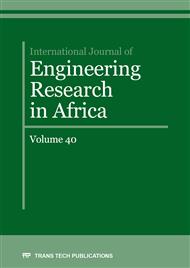[1]
P. Sekhar and S. Mohanty, An online power system static security assessment module using multi-layer perceptron and radial basis function network,, International Journal of Electrical Power and Energy Systems, vol. 76, no. 1, p.165–173, (2016).
DOI: 10.1016/j.ijepes.2015.11.009
Google Scholar
[2]
D. P. Kothari and I. J. Nagrath, Modern Power System Analysis, Third. New Delhi: Tata McGraw Hill Education Private Limited, (2003).
Google Scholar
[3]
A. Y. Abdelaziz, S. F. Mekhamer, M. A. L. Badr, and H. M. Khattab, Static Security Enhancement and Loss Minimization Using Simulated Annealing,, International Journal of Intelligent Systems and Applications, vol. 5, no. 4, p.30–42, (2013).
DOI: 10.5815/ijisa.2013.04.03
Google Scholar
[4]
M. Maharana and S. Malakar, Sensitivity Based Network Contingency Ranking Using Newton Raphson Power Flow Method,, International Journal of Scientific Engineering and Technology, vol. 49, no. 4, p.45–49, (2015).
DOI: 10.17950/ijset/v4s2/204
Google Scholar
[5]
K. R. Rani, J. Amarnath, and S. Kamakshaiah, Contingency Analysis under Deregulated Power Systems,, Automatic Control and Systems Engineering Journal, vol. 11, no. 2, p.1–8, (2011).
Google Scholar
[6]
M. K. Singh and N. Saxena, Performance Analysis and Comparison of Various FACTS Devices in Power System,, International Journal of Electrical, Electronics and Computer Engineering, vol. 2, no. 2, p.40–46, (2013).
Google Scholar
[7]
X.-P. Zhang, C. Rehtanz, and B. Pal, Flexible AC Transmission Systems : Modelling and Control. Dortmund, Germany: Springer, (2012).
Google Scholar
[8]
C. Rehtanz and J. J. Zhang, New types of FACTS-devices for power system security and efficiency,, in IEEE Lausanne POWERTECH, Proceedings, 2007, p.293–298.
DOI: 10.1109/pct.2007.4538332
Google Scholar
[9]
K. S. Sundar and H. M. Ravikumar, Enhancement of system performance and static security through an optimal placement of SVC,, in IEEE Region 10 Annual International Conference, Proceedings/TENCON, 2008, p.19–21.
DOI: 10.1109/tencon.2008.4766799
Google Scholar
[10]
G. Shahgholian, M. Mahdavian, M. Janghorbani, I. Eshaghpour, and E. Ganji, Analysis and Simulation of UPFC in Electrical Power System for Power Flow Control,, in IEEE International Conference on Electrical Engineering/Electronics, Computer, Telecommunications and Information Technology (ECTI-CON), 2017, p.62–65.
DOI: 10.1109/ecticon.2017.8096173
Google Scholar
[11]
H. Jmii, A. Meddeb, and S. Chebbi, An approach for improving voltage stability by combination of SVC and TCSC,, in 2016 7th International Conference on Sciences of Electronics, Technologies of Information and Telecommunications, SETIT 2016, 2017, p.134–141.
DOI: 10.1109/setit.2016.7939855
Google Scholar
[12]
E. Buraimoh, F. K. Ariyo, and I. E. Davidson, Power System Static Security Enhancement Through Interline Power Flow Controller,, in IEEE PES & IAS Power Africa Conference, 2018, p.1–6.
DOI: 10.1109/powerafrica.2018.8520992
Google Scholar
[13]
P. T. Boggs and J. W. Tolle, Sequential Quadratic Programming for Large-Scale Nonlinear Optimization,, Journal of Computational and Applied Mathematics, vol. 124, no. 1–2, p.123–137, (2000).
DOI: 10.1016/s0377-0427(00)00429-5
Google Scholar
[14]
J. Carpentier, Static Security Assessment and Control : a Short Survey,, in IEEE Joint International Power Conference Athens Power Tech, 1993. APT 93. Proceedings, 1993, p.1–9.
DOI: 10.1109/apt.1993.686833
Google Scholar
[15]
H. M. Khattab, A. A. Y., S. F. Mekhamer, and M. A. L. Badr, Static Security Assessment Using a Probabilistic Neural Network Based Classifier,, The Online Journal on Electronics and Electrical Engineering (OJEEE), vol. 3, no. 4, p.454–461, (2011).
Google Scholar
[16]
P. Ramanaiah and J. S. Rao, Contingency Analysis in Deregulated Power System Using FACTS Device ( TCSC ),, International Journal of Engineering Research and Development, vol. 10, no. 10, p.44–64, (2014).
Google Scholar


